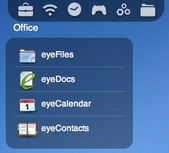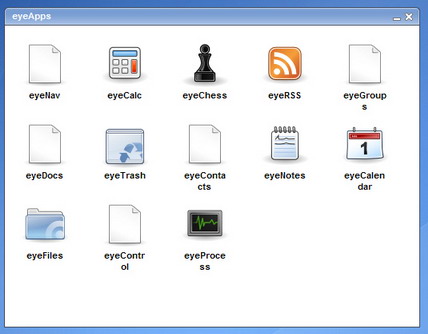Release eyeOS webOS 1.0 Dahlia
 The ideology of Software as a service (SaaS) continues to evolve: on June 4, 2007, a new version of the eyeOS 1.0 web-based operating system was introduced. Nice interface, software suite, 120,518 users (up from 53,500 in August 2006), Open Source. As you know, the essence of WebOS - a virtual desktop in your browser - allows you to access information from any place where there is access to the Internet. In this case, in addition to the opportunity to work at home and in the office, you also get the opportunity to create applications yourself. The convenience of programming tools is excellent.
The ideology of Software as a service (SaaS) continues to evolve: on June 4, 2007, a new version of the eyeOS 1.0 web-based operating system was introduced. Nice interface, software suite, 120,518 users (up from 53,500 in August 2006), Open Source. As you know, the essence of WebOS - a virtual desktop in your browser - allows you to access information from any place where there is access to the Internet. In this case, in addition to the opportunity to work at home and in the office, you also get the opportunity to create applications yourself. The convenience of programming tools is excellent.To date, such projects are already more than a dozen, analysts with might and main compare the best web operating systems (review published in December 2006). The conclusion is: “the area is quite promising, but still young and suffering from many childhood diseases. We would say that YouOS , Goowy and DesktopTwo are names that need to be monitored now and in the near future, while others may well become promising products. ”
The release of eyeOS 1.0 Dahlia took place after the formation of this conclusion - since the first appearance in August 2006, the system was completely rewritten, the interface was changed. At the same time, eyeOS is still an Open Source project with a GPL license.
 One of the creators, Eduardo Perez Orue , says that "the importance of eyeOS 1.0 is not in the beauty of the interface or the set of applications, but in the core of the system." “We designed eyeOS 1.0 as a normal operating system, with its own microkernel that loads services (such as virtual file system, security system, graphics and interface display) and libraries (such as XML, ZIP, TAR support, widgets for creating applications) ".
One of the creators, Eduardo Perez Orue , says that "the importance of eyeOS 1.0 is not in the beauty of the interface or the set of applications, but in the core of the system." “We designed eyeOS 1.0 as a normal operating system, with its own microkernel that loads services (such as virtual file system, security system, graphics and interface display) and libraries (such as XML, ZIP, TAR support, widgets for creating applications) ".Eduardo: “We have created a complete set of tools for developing Internet applications”, calling it “a new way of developing Internet applications” —that is, a wide range of web applications based on Ajax technologies with “greater control over the security subsystem and the eyeOS core management” In fact, everything in the system is done using the eyeOS toolkit. Developers need only to connect the “widgets” of the applications together and create functions for them - “eyeOS takes care of the rest”.

Projects like this will undoubtedly have a great future. Today, everyone can take part in approaching this future by joining the community and writing software for eyeOS.
The operating system interface looks more than decent, working, you forget that you are in the browser. Now to learn how to apply all this beauty with benefit - the question of whether this is possible remains open. Does anyone use similar tools in their work, is there any good in this?
When reprinting, please refer to this text.
The author of the text will be grateful for comments, comments, corrections of possible inaccuracies and participation in the correction of the material.
The topic is based on information from the following sources: www.readwriteweb.com/archives/eyeos_10_launches.php
www.digg.com
www.eyeos.info
en.wikipedia.org/wiki/Web_operating_system
franticindustries.com/blog/2006/12/21/big-webos-roundup-10-online-operating-systems-reviewed
')
Source: https://habr.com/ru/post/9467/
All Articles